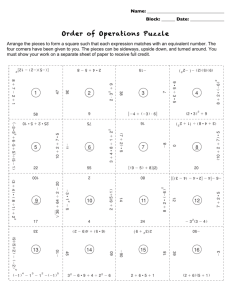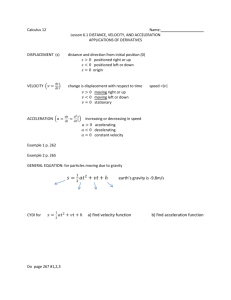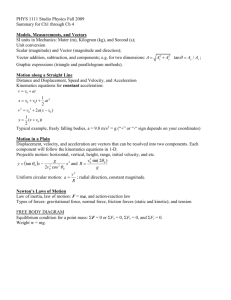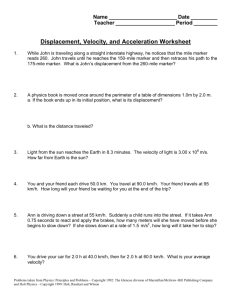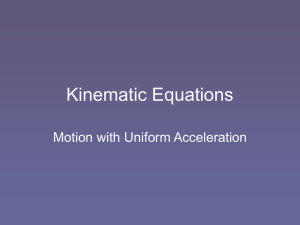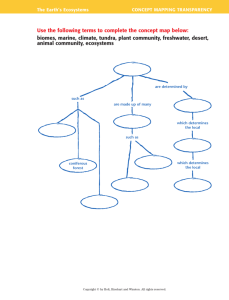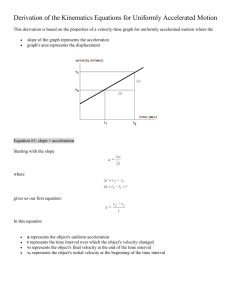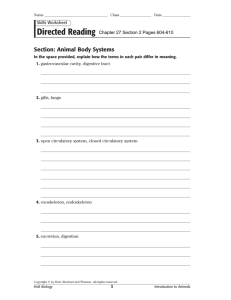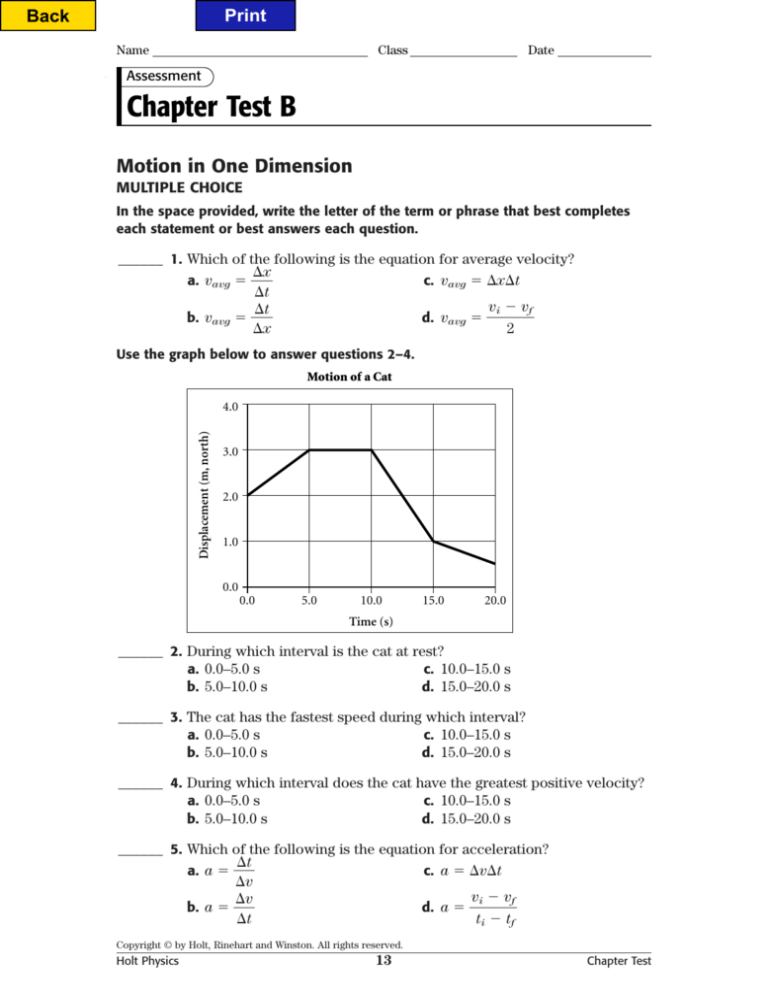
Back
Print
Name
Class
Date
Assessment
Chapter Test B
Motion in One Dimension
MULTIPLE CHOICE
In the space provided, write the letter of the term or phrase that best completes
each statement or best answers each question.
______ 1. Which of the following is the equation for average velocity?
x
a. vavg c. vavg xt
t
vi vf
t
b. vavg d. vavg x
2
Use the graph below to answer questions 2–4.
Motion of a Cat
Displacement (m, north)
4.0
3.0
2.0
1.0
0.0
0.0
5.0
10.0
15.0
20.0
Time (s)
______ 2. During which interval is the cat at rest?
a. 0.0–5.0 s
c. 10.0–15.0 s
b. 5.0–10.0 s
d. 15.0–20.0 s
______ 3. The cat has the fastest speed during which interval?
a. 0.0–5.0 s
c. 10.0–15.0 s
b. 5.0–10.0 s
d. 15.0–20.0 s
______ 4. During which interval does the cat have the greatest positive velocity?
a. 0.0–5.0 s
c. 10.0–15.0 s
b. 5.0–10.0 s
d. 15.0–20.0 s
______ 5. Which of the following is the equation for acceleration?
t
a. a c. a vt
v
vi vf
v
b. a d. a ti tf
t
Copyright © by Holt, Rinehart and Winston. All rights reserved.
Holt Physics
13
Chapter Test
Back
Print
Name
Class
Date
Chapter Test B continued
______ 6. When a car’s velocity is negative and its acceleration is negative, what
is happening to the car’s motion?
a. The car slows down.
b. The car speeds up.
c. The car travels at constant speed.
d. The car remains at rest.
7.0
______ 7. What does the graph on the right
illustrate about acceleration?
a. The acceleration varies.
b. The acceleration is zero.
c. The acceleration is constant.
d. The acceleration increases then
becomes constant.
6.0
Velocity (m/s)
5.0
A
4.0
3.0
______ 8. In the graph on the right, how does
the acceleration at A compare with
2.0
B
the acceleration at B?
a. The acceleration at A is positive
1.0
and less than the acceleration at B.
b. The acceleration at B is positive
0
2.0
4.0
6.0
8.0
and less than the acceleration at A.
Elapsed time (s)
c. The accelerations at A and B are
each zero.
d. The accelerations at A and B cannot be determined.
10.0
______ 9. Which of the following line segments on a velocity versus time graph is
physically impossible?
a. horizontal line
b. straight line with positive slope
c. straight line with negative slope
d. vertical line
Motion of Ball Moving on Ramp
E
Speed
______10. In the graph at the right, at
what point is the speed of the
ball equal to its speed at B?
a. A
b. C
c. D
d. none of the above
D
0
0
C
B
A
Time
Copyright © by Holt, Rinehart and Winston. All rights reserved.
Holt Physics
14
Chapter Test
Back
Print
Name
Class
Date
Chapter Test B continued
______11. A baseball catcher throws a ball vertically upward and catches it in the
same spot as it returns to the mitt. At what point in the ball’s path does
it experience zero velocity and nonzero acceleration at the same time?
a. midway on the way up
b. at the top of its path
c. the instant it leaves the catcher’s hand
d. the instant before it arrives in the catcher’s mitt
SHORT ANSWER
12. Distinguish between the displacement of a traveler who takes a train from
New York to Boston and the displacement of a traveler who flies from Boston
to New York. Be sure to compare the magnitudes of the displacements.
13. If a runner moves from a positive position to a negative position, explain if
the runner’s displacement is negative or positive.
14. Explain how a dog that has moved can have a displacement of zero.
15. Why is the direction of free-fall acceleration usually negative?
PROBLEM
16. A biker travels at an average speed of 18 km/h along a 0.30-km straight segment
of a bike path. How much time does the biker take to travel this segment?
Copyright © by Holt, Rinehart and Winston. All rights reserved.
Holt Physics
15
Chapter Test
Back
Print
Name
Class
Date
Chapter Test B continued
17. A hiker travels south along a straight path for 1.5 h with an average speed of
0.75 km/h and then travels north for 2.5 h with an average speed of 0.90 km/h.
What is the hiker’s displacement for the total trip?
18. A skater glides off a frozen pond onto a patch of ground at a speed of 1.8 m/s.
Here she is slowed at a constant rate of 3.00 m/s2. How fast is the skater
moving when she has slid 0.37 m across the ground?
19. Human reaction time is usually about 0.20 s. If your lab partner holds a ruler
between your finger and thumb and releases it without warning, how far can
you expect the ruler to fall before you catch it? (Disregard air resistance. a g 9.81 m/s2.)
20. A pair of glasses are dropped from the top of a 32.0 m high stadium. A pen is
dropped 2.00 s later. How high above the ground is the pen when the glasses
hit the ground? (Disregard air resistance. a g 9.81 m/s2.)
Copyright © by Holt, Rinehart and Winston. All rights reserved.
Holt Physics
16
Chapter Test
Print PAGE
TEACHER RESOURCE
19. 10 000 or 104 Earths; 1.17 104 Earths
18. The dog is moving at a constant speed
because the position versus time graph
is a straight line with a positive slope.
Given
REarth 6.37 106 m
Average Earthsun distance 1.496 1011
NEarths between Earth and the sun ?
Solution
DiameterEarth 2(REarth) 2(6.37 106 m) 1.27 107 m
Therefore, using an order-of-magnitude
calculation, the estimate for the number of Earths that would fit between
Earth and the sun is
5.0
Position (m)
Back
1.
2.
3.
4.
5.
6.
7.
8.
17.
a
d
c
b
c
d
c
a
displacement
9.
10.
11.
12.
13.
14.
15.
16.
d
a
c
c
c
a
a
c
1.0 2.0 3.0 4.0 5.0 6.0 7.0 8.0 9.0 10.0
Time (s)
19. 3.3 m/s, to the right
Given
xi 12 m
xf 24 m
t 11 s
Solution
xf xi
x
vavg t
t
20. Yes; trial 2 has a much greater T over
CHAPTER TEST A (GENERAL)
2.0
0
1.17 104 Earths
Motion in One Dimension
3.0
1.0
1011
10 000 or 104.
107
Exact number of Earths is
(1.496 1011 m)
2(6.37 106 m)
the same period of time; temperature
increases as time increases;
Since the table indicates a direct relationship between T and t, the general form of the equation is y mx. If
T is graphed on the y-axis and t is
graphed on the x-axis, m represents
T
the slope or . In this instance,
t
T
the average of is 0.12.
t
Therefore, the equation would be
T 0.12t.
4.0
(24 m) (12 m)
11 s
3.3 m/s, to the right
20. 44 m
Given
a g 9.81 m/s2
t 2.0 s
vi 12 m/s
Solution
1
x vit 2a(t)2 vit 1
(g)(t)2
2
x (12.0 m/s)(2.0 s) 1
(9.81
2
m/s2)(2.0 s)2 44m
Motion in One Dimension
CHAPTER TEST B (ADVANCED)
1.
2.
3.
4.
5.
11.
12.
a
6. b
b
7. a
c
8. c
a
9. d
b
10. c
b
Although the magnitudes of the displacements are equal, the displacements are in opposite directions.
Therefore, one displacement is positive and one displacement is negative.
Copyright © by Holt, Rinehart and Winston. All rights reserved.
Holt Physics
178
Chapter Test
Back
Print PAGE
TEACHER RESOURCE
13. The displacement is negative because
Solution
1
x vit 2a(t)2 a change of position in the direction
opposite of increasing positive position is negative displacement.
14. The dog’s initial position and its final
position are the same position.
15. Since the usual choice of coordinates
uses positive as the direction away
from Earth, the direction of free-fall
acceleration is negative because the
object accelerates toward Earth.
16. 1.7 102 h
Given
vavg 1.8 km/h
x 0.30 km
1
vit 2(g)(t)2
x (0 m/s)(0.20 s) 1
(9.81
2
20. 30.5 m
Given
a g 9.81 m/s2
vi,1 0.0 m/s
x 32.0 m
vi,1 0.0 m/s
t1,2 2.0 s
Solution
1
x1 vi,1t1 2a(t1)2 Solution
x
vavg t
x
0.30 km
t 1.7 102 h
vavg
18 km/h
17. 1.2 km, north
Given
vavg,1 0.75 km/h
t1 1.5 h
vavg,2 0.90 km/h
t2 2.5 h
1
vi,1t1 2(a)(t1)2
2x
2x
a
g
2(32.0 m)
2.56 s
9.81
m/s
t1 1
(g)(t2)2
2
x2 (0.0 m/s)(0.56 s) 1
(9.81
2
m/s2)(0.56 s)2 1.5 m
h 32.0 m 1.5 m 18. 1.0 m/s
30.5 m
Two-Dimensional Motion
and Vectors
Given
vi 1.8 m/s
a 3.00 m/s2
x 0.37 m
CHAPTER TEST A (GENERAL)
Solution
vf2 vi2 2ax
2
vf v
i 2ax
2
(1.8
m/s)
(2)(3.0
m/
s2)(0.37
m)
Given
a g 9.81 m/s2
t 0.20 s
vi 0.0 m/s
1
t2 t1 t1,2 2.56 s 2.00 s 0.56 s
1
x2 vi,2t2 2a(t2)2 vi,2t2 (0.90 km/h)(2.5 h) 1.2 km, north
19. at least 0.20 m
1
2
Solution
x x1 x2 vavg,1t1 vavg,2t2
x (0.75 km/h)(1.5 h) vf 1.0 m/s
m/s2)(0.20 s)2 0.20 m
1.
2.
3.
4.
5.
6.
7.
8.
17.
18.
b
9. d
a
10. b
b
11. b
d
12. a
a
13. c
a
14. b
c
15. c
b
16. a
Displacement is a vector quantity.
The vectors must be perpendicular to
each other.
19. 120 m
Given
vi 12 m/s at 30.0° above the
horizontal
t 5.6 s
q 9.81 m/s2
Copyright © by Holt, Rinehart and Winston. All rights reserved.
Holt Physics
179
Chapter Test

